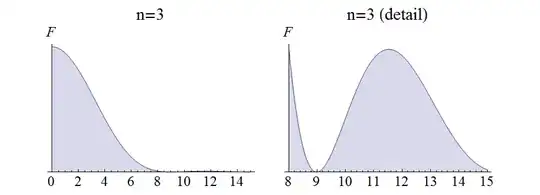There are at least two conventional meanings of "spherical covariance function." Based on the conclusion you want to draw, we can infer you are referring to the family of functions $G:\mathbb{R}^n\to \mathbb{R}$ based on
$$G(\mathbf{h}) = 1 - \frac{3|\mathbf{h}|}{2} + \frac{|\mathbf{h}|^3}{2},\ 0 \le |\mathbf{h}| \le 1,$$
and otherwise $G=0.$ ("Based on" means we can ignore scale factors in both $\mathbf h$ and $G$ without any loss of generality merely by choosing our units of measurement appropriately.)
A positive-(semi)definite covariance $C$ is one that satisfies
$$\sum_{j,k} a_j C(\mathbf{y}_j - \mathbf{y}_k) \bar{a_k} \ge 0$$
for any collection of locations $\mathbf{y}_i \in \mathbb{R}^n, i=1,2,\ldots, m$ and all possible complex numbers $(a_i), i=1,2,\ldots, m.$ In other words, the covariance matrix associated with any set of locations is positive-semidefinite.
Bochner's Theorem asserts that all positive-definite covariances arise as the Fourier transforms of finite positive measures $F$ given by
$$\hat F(\mathbf{h}) = \int_{\mathbb{R}^n} e^{i\mathbf{h}\cdot \mathbf{x}} F(\mathrm{d}\mathbf{x}).$$
Indeed, by interchanging summation and integration we may check that
$$\eqalign{
\sum_{j,k} a_j C(\mathbf{y}_j - \mathbf{y}_k) \bar{a_k} &= \sum_{j,k}\int_{\mathbf{R}^n}a_j e^{i(\mathbf{y}_j - \mathbf{y}_k)\cdot \mathbf{x}} \bar{a}_kF(\mathrm{d}\mathbf{x}) \\
&= \int_{\mathbf{R}^n} \sum_j a_j e^{i\mathbf{y}_j\cdot \mathbf{x}}\ \sum_k \overline{e^{i\mathbf{y}_k \cdot\mathbf{x}}a_k}\ F(\mathrm{d}\mathbf{x}) \\
&= \int_{\mathbf{R}^n} \left|\sum_j a_j e^{i\mathbf{y}_j\cdot \mathbf{x}}\ \right|^2\ F(\mathrm{d}\mathbf{x}) \ge 0.
}$$
Because (for spherical covariances) the expression $ C(\mathbf{y}_j - \mathbf{y}_k) $ depends only on the separation distances $r_{jk}=|\mathbf h_{jk}| = |\mathbf{y}_j - \mathbf{y}_k|,$ the Fourier transform can be inverted (to find $F$ from $G$) with a single integration. By doing the calculation we find the following measures $F(\mathrm{d}\mathbf{x}) = F(r)\mathrm{d}r \mathrm{d}\Omega$ in spherical coordinates $(r, \Omega)$ for $n=3,4:$
$$n=3:\ F(r) \propto r^{-6}\left(r \cos(r/2) - 2 \sin(r/2)\right)^2 \ge 0.$$

$$n=4:\ F(r) \propto r^{-6}\left(\left(r^2+5\right) (\pmb{H}_0(r) J_1(r)-\pmb{H}_1(r) J_0(r))+30 r (r J_0(r)-3 J_1(r))\right),$$
an algebraic combination of Bessel J functions $J_i$ and Struve H functions $\pmb{H}_i.$

Because some of the possible values of this density are negative, the spherical covariance function for $n=4$ is not positive-definite.
We are actually done: we don't have to consider all possible dimensions. The reason is that some configurations of points in $\mathbb{R}^n$ actually lie within lower-dimensional subspaces. Consequently, it is immediate from the definition of positive-definite functions that
When a covariance in $\mathbb{R}^n$ is positive-definite, it remains positive-definite in all lower dimensions.
When a covariance in $\mathbb{R}^n$ fails to be positive-definite, it fails in all higher dimensions.
Reference
This post broadly follows the exposition in a set of Duke University lecture notes (unattributed and undated) found at https://www2.stat.duke.edu/courses/Fall01/sta293/lecs/covar.pdf. Its bibliography covers the classics: Yaglom, Matern, Ripley, Cressie.

